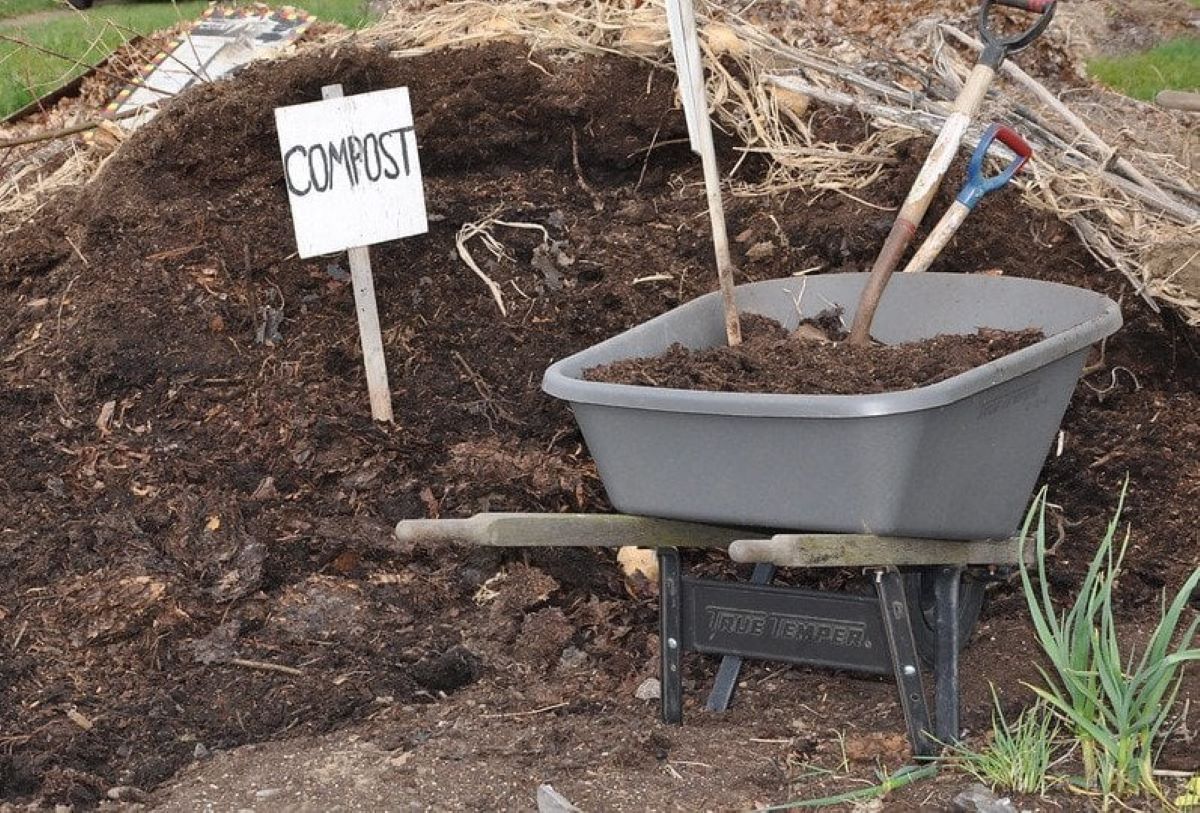Home>Gardening News and Trends>Gardening Trends>How Does Soil Incorporate All 4 Spheres


Gardening Trends
How Does Soil Incorporate All 4 Spheres
Modified: February 9, 2024
Discover how soil plays a crucial role in gardening trends by incorporating all 4 spheres - atmosphere, lithosphere, hydrosphere, and biosphere.
(Many of the links in this article redirect to a specific reviewed product. Your purchase of these products through affiliate links helps to generate commission for Chicagolandgardening.com, at no extra cost. Learn more)
Table of Contents
Introduction
The Earth is a complex and interconnected system consisting of various components that work together to sustain life. These components are often referred to as the four spheres of the Earth: the atmosphere, hydrosphere, biosphere, and geosphere. Each sphere plays a vital role in maintaining the delicate balance of our planet.
One essential element that connects and influences all four spheres is soil. Soil is a mixture of minerals, organic matter, water, air, and living organisms that covers the Earth’s surface. It serves as a foundation for plants to grow, filters and stores water, regulates the atmospheric composition, and provides habitat for countless organisms.
In this article, we will explore the significant role of soil in incorporating and interacting with the four spheres of the Earth. From its impact on the atmosphere to its influence on the hydrosphere, biosphere, and geosphere, we will delve into the intricate relationships between soil and the other spheres.
By understanding how soil interconnects with the four spheres, we can gain a deeper appreciation for the vital role it plays in sustaining life on Earth. So, let’s embark on this journey to explore the remarkable ways in which soil integrates with each sphere and contributes to the overall health and functioning of our planet.
The Four Spheres of the Earth
The Earth can be divided into four interconnected spheres that encompass different aspects of our planet. These spheres include the atmosphere, hydrosphere, biosphere, and geosphere.
The atmosphere is the layer of gases that surrounds the Earth. It consists of nitrogen, oxygen, carbon dioxide, and other trace elements. The atmosphere plays a critical role in regulating temperature, protecting against harmful radiation, and providing the oxygen needed for life on Earth.
The hydrosphere encompasses all the water on Earth, including oceans, lakes, rivers, and groundwater. It is a vital component for life, serving as a habitat for aquatic organisms, a source of drinking water, and a medium for transportation and weather systems.
The biosphere includes all living organisms on Earth, ranging from plants and animals to microorganisms. It is a complex web of life that depends on interactions between different species and their environment.
The geosphere refers to the solid part of the Earth, including rocks, minerals, and the layers that make up the Earth’s interior. It includes the Earth’s crust, mantle, and core, and it influences geological processes such as earthquakes, volcanoes, and the formation of mountains.
These four spheres are intricately connected and depend on each other for their functioning. Changes in one sphere can have cascading effects on the others and ultimately impact the overall health and balance of our planet.
Now that we have a basic understanding of the four spheres of the Earth let’s explore how soil, the focus of this article, interacts with and incorporates each sphere. By examining these interactions, we can gain insights into the essential role of soil in sustaining the delicate equilibrium of our planet.
Understanding Soil
Soil is much more than just dirt. It is a complex and dynamic substance that forms the foundation for life on Earth. Understanding the composition and characteristics of soil is crucial for comprehending its role in the four spheres of the Earth.
Soil is a mixture of mineral particles, organic matter, water, air, and living organisms. The mineral particles, which mainly consist of weathered rock fragments, provide structural stability and contribute to the chemical properties of soil. The organic matter, derived from decaying plants and animals, provides nutrients and serves as a habitat for a wide range of soil organisms.
Soil can vary greatly in texture, from sandy soils with large particles to clayey soils with fine particles. The texture affects the soil’s ability to retain water and nutrients, as well as its capacity to allow root penetration. Additionally, soil fertility is determined by its nutrient content, which can be influenced by factors such as climate, parent material, and biological processes.
Soil is not a static entity; it undergoes constant physical, chemical, and biological transformations. Physical processes such as weathering and erosion shape the soil, while chemical processes like nutrient cycling and pH changes affect its fertility. Biological activity in the soil, led by a diverse array of organisms including bacteria, fungi, insects, and earthworms, contributes to nutrient cycling, organic matter decomposition, and soil structure formation.
The diversity of soil organisms is crucial for maintaining soil health. These organisms participate in various ecological interactions, such as symbiotic relationships where plants and microbes exchange nutrients, predator-prey relationships, and decomposition processes. They contribute to the overall resilience and productivity of the soil ecosystem.
Understanding the complexity of soil composition and its dynamic nature allows us to appreciate its significance in supporting life on Earth. From providing a medium for plant growth to facilitating water and nutrient cycles, soil plays a vital role in connecting the four spheres of the Earth.
Importance of Soil in the Four Spheres
Soil is a critical component that profoundly influences the functioning of the four spheres of the Earth. Its importance can be seen in the interactions and contributions it makes to each sphere.
In the atmosphere, soil plays a crucial role in regulating the composition of gases. Through a process known as carbon sequestration, soil acts as a sink for atmospheric carbon dioxide, helping to mitigate climate change. Additionally, soil releases gases like oxygen and nitrous oxide, which have implications for atmospheric chemistry and climate patterns.
In the hydrosphere, soil acts as a filter and buffer, purifying and retaining water. As rainwater percolates through the soil, its physical and biological properties remove pollutants and impurities, preventing them from reaching water bodies. Moreover, soil acts as a reservoir, storing water and slowly releasing it to maintain groundwater levels, regulate stream flow, and prevent runoff and erosion.
In the biosphere, soil is the foundation for plant growth, serving as a nutrient-rich medium that anchors roots and provides essential elements for photosynthesis. Soil supplies plants with water, minerals, and oxygen, allowing them to thrive and support diverse ecosystems. Furthermore, soil provides habitat for a vast array of organisms, from earthworms and insects to fungi and bacteria, which contribute to nutrient cycles, decomposition, and soil structure formation.
In the geosphere, soil represents the top layer of the Earth’s crust and is intricately linked to geological processes. Soil formation through weathering and erosion is a result of the interaction between the lithosphere (rock layer) and the other spheres. Soil acts as a record of past geological events, preserving information about the Earth’s history and providing insight into past climates and landscapes.
The interconnectedness and contributions of soil to the four spheres highlight its significance in maintaining the equilibrium of the Earth. It is essential for us to recognize and protect soil resources to ensure the sustainability and well-being of our planet.
How Soil Incorporates the Atmosphere
Soil plays a critical role in incorporating and interacting with the atmosphere, influencing its composition and affecting climate patterns.
One significant way soil incorporates the atmosphere is through carbon sequestration. Plants absorb carbon dioxide from the atmosphere during photosynthesis and store carbon in their tissues. When plants die and decompose, much of this stored carbon is returned to the soil. Soil acts as a reservoir for carbon, preventing it from being released back into the atmosphere as carbon dioxide. This process helps to mitigate climate change by reducing the concentration of greenhouse gases in the atmosphere.
In addition to carbon sequestration, soil also releases important gases into the atmosphere. Soil bacteria and fungi play a crucial role in nitrogen cycling, converting nitrogen from the atmosphere into a form that plants can use. This process, known as nitrogen fixation, releases nitrogen gas back into the atmosphere and contributes to the nitrogen balance in the atmosphere.
Soil also emits gases such as oxygen and nitrous oxide. Oxygen is released into the atmosphere through the respiration of soil organisms, while nitrous oxide is produced through microbial processes in the soil. Nitrous oxide is a potent greenhouse gas that contributes to climate change and plays a role in the atmospheric chemistry.
Furthermore, soil influences climatic patterns through its impact on moisture and temperature. Healthy soils with good water-holding capacity retain moisture and release it slowly, helping to maintain humidity levels in the atmosphere. Soil also acts as an insulator, regulating the temperature of the underlying layers. This buffering effect helps to mitigate temperature extremes and contributes to local climate stability.
Overall, soil serves as a vital interface between the Earth’s surface and the atmosphere. Its ability to sequester carbon, release gases, regulate moisture, and influence temperature all contribute to the complex dynamics of the atmosphere. Understanding these processes is crucial for managing soil resources and mitigating the effects of climate change.
How Soil Incorporates the Hydrosphere
Soil plays a crucial role in incorporating and interacting with the hydrosphere, influencing water availability, quality, and the overall functioning of aquatic ecosystems.
One of the primary ways soil incorporates the hydrosphere is through its ability to retain and store water. When it rains, soil acts as a sponge, absorbing water and preventing immediate runoff. This process, known as infiltration, allows water to percolate through the soil, recharging groundwater reserves and maintaining water levels in rivers, lakes, and streams. By regulating the flow of water, soil helps to prevent flooding and erosion, ensuring a more balanced hydrological cycle.
Furthermore, soil filters and purifies water as it moves through its layers. The physical and biological properties of the soil effectively trap and degrade pollutants, preventing them from reaching water bodies. Soil acts as a natural water treatment system, removing sediments, nutrients, and harmful substances, thus improving water quality.
Soil also plays a role in shaping the hydrological cycle through evapotranspiration. As plants extract water from the soil through their roots, the excess water is released into the atmosphere through tiny openings called stomata on their leaves. This process not only helps to cool the plants but also contributes to the overall moisture content in the atmosphere. Through evapotranspiration, soil facilitates the movement of water from the hydrosphere to the atmosphere, influencing weather patterns and regional climate.
Soil moisture content also affects the growth and distribution of plants, which, in turn, have a significant impact on the hydrosphere. Vegetation cover provided by plants reduces the impact of rainfall, preventing soil erosion by intercepting rainfall and allowing it to be absorbed gradually. Additionally, plant roots stabilize the soil and enhance its ability to store water, further contributing to the balance of the hydrosphere.
The intricate interactions between soil and the hydrosphere highlight the vital role soil plays in water management and the overall health of aquatic ecosystems. By understanding and nurturing these connections, we can better protect and utilize water resources sustainably, ensuring the functioning of the hydrosphere for generations to come.
How Soil Incorporates the Biosphere
Soil is a fundamental component of the biosphere, providing a crucial foundation for the growth and sustenance of all forms of life on Earth.
One of the primary ways soil incorporates the biosphere is by serving as a medium for plant growth. The mineral particles, organic matter, and moisture present in the soil provide essential nutrients and support root development. Plants draw nutrients, water, and oxygen from the soil, allowing them to photosynthesize and produce energy. In turn, plants form the basis of food chains, supporting the entire ecosystem and providing habitat for a wide range of organisms.
Soil also acts as a living ecosystem itself, teeming with a diverse array of microorganisms, insects, worms, and other soil-dwelling organisms. These organisms play vital roles in nutrient cycling, decomposition, and soil structure formation. Bacteria and fungi break down organic matter, releasing nutrients for plant uptake. Nematodes and other microscopic animals contribute to nutrient cycling and help control pests. Earthworms improve soil structure through their burrowing activities, enhancing aeration and drainage.
The variety of soil organisms directly influences the health and fertility of the soil. Soil biodiversity promotes nutrient availability, organic matter decomposition, and nutrient cycling, all of which are essential for the sustainability of the biosphere. Moreover, the interactions between soil organisms and plants create symbiotic relationships, such as mycorrhizae, where fungi and plants exchange nutrients, benefiting both organisms.
Soil acts as a habitat for many organisms, from microscopic bacteria to larger animals. The structure and composition of the soil provide refuge, breeding grounds, and food sources for countless species. This makes soil a critical component of biodiversity, supporting the intricate web of life in the biosphere.
Additionally, soil plays a role in shaping the diversity and distribution of ecosystems. Different types of soil support different plant communities, influencing the composition and structure of habitats and ecosystems. From forests to grasslands, wetlands to deserts, soil characteristics help determine the vegetation composition, which, in turn, influences the types of animals that inhabit the area.
The vital role of soil in supporting plant growth, nutrient cycling, and providing habitat underscores its deep integration with the biosphere. By understanding and prioritizing the conservation of soil ecosystems, we can ensure the preservation and productivity of the biosphere for future generations.
How Soil Incorporates the Geosphere
Soil is an integral part of the geosphere, representing the top layer of the Earth’s crust and playing a significant role in shaping geological processes and landscapes.
One way soil incorporates the geosphere is through its involvement in weathering and erosion. Weathering is the breakdown of rocks and minerals, and soil formation is a result of the weathering process. Over time, physical, chemical, and biological processes break down rocks into smaller particles, contributing to the development of soil. Soil acts as a medium for weathering agents, such as water and wind, facilitating their interaction with the underlying rock layers.
Soil also influences erosion processes. Vegetation cover provided by plants stabilizes the soil, preventing erosion caused by runoff and wind. The roots of plants penetrate the soil, binding it together and reducing the risk of soil loss. By mitigating erosion, soil helps to maintain the integrity of the geosphere and prevents the loss of valuable topsoil required for sustainable agriculture.
Moreover, soil composition and characteristics provide clues about the geological history of an area. By studying soil profiles and analyzing the types of minerals and sediments present, scientists can gain insights into past geological events, such as volcanic activity, erosion patterns, and the formation of landforms. Soil acts as a record of the geologic processes that have shaped the Earth’s surface over millions of years.
Soil is also intimately linked with the geosphere through its connection to landforms and landscapes. Different soil types and properties can give rise to diverse landforms, such as hills, valleys, and plateaus. The underlying geology influences the formation of soil, and, in turn, the soil influences the physical characteristics and stability of landforms.
Furthermore, soil plays a role in groundwater recharge and aquifer storage. As water infiltrates through the soil layers, it replenishes groundwater reserves, which are essential for sustaining ecosystems and providing water supplies for human societies. Understanding the hydraulic properties of soil is crucial for managing water resources and ensuring the long-term availability of water from aquifers.
The intricate relationship between soil and the geosphere highlights its influence in shaping the Earth’s surface and the geological processes that occur within it. By recognizing and conserving soil resources, we can better protect the integrity of the geosphere and ensure its sustainable use for future generations.
Conclusion
Soil is an incredible and complex medium that seamlessly incorporates and interacts with all four spheres of the Earth: the atmosphere, hydrosphere, biosphere, and geosphere. It serves as a vital link that connects and influences these spheres, playing a fundamental role in maintaining the balance and sustainability of our planet.
From its ability to sequester carbon and release gases into the atmosphere, to its capacity to filter and store water in the hydrosphere, soil contributes to the functionality of each sphere. It forms the foundation for plant growth and provides habitat for countless organisms, thus supporting the rich biodiversity of the biosphere. Additionally, soil is intertwined with the geosphere through its involvement in weathering, erosion, and the formation of landforms.
Understanding the interactions between soil and the four spheres helps us appreciate the significance of soil in sustaining life and maintaining the health of our planet. It highlights the crucial role of soil in regulating atmospheric composition, influencing water availability and quality, supporting plant growth, conserving geological history, and shaping landscapes.
However, it is essential to recognize the importance of responsible soil management and conservation. Uncontrolled soil degradation, such as erosion, pollution, and loss of soil biodiversity, threatens the delicate balance of the interconnected spheres. Taking measures to preserve soil health, promote sustainable land use practices, and combat soil erosion is crucial for safeguarding the well-being of our planet and future generations.
In conclusion, soil is more than just a medium for plant growth – it is a dynamic and integral part of the Earth’s system. It is essential for us to value and protect this precious resource to ensure the continued functioning and resilience of our planet’s ecosystems.



